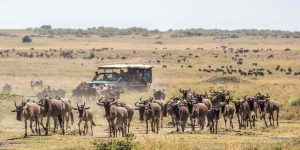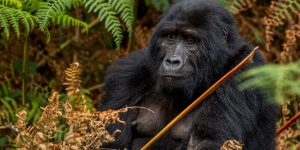The wildebeest migration is an annual mass movement of wildebeests, zebras and gazelles over the Masai Mara and Serengeti ecosystems. It follows seasonal rains as herds move in search for fresh pastures. The migrating herds move through dangerous Big Cat and Nile Crocodiles territories.
Wildebeests are the majority of the herds numbering to 1.5 million. Zebras range from 250,000 to 300,000 individuals plus other antelopes including Thompson gazelles and the Topi. Wildebeests belong to the antelope family and entirely depend on the grass of the open savanna and woodland plains.
These migrating herds cover a total distance of about 800 to 1000 kilometers along the migration circuit if they survive. Survival on this journey is limited because of predators and the steep slopes on the River banks where some break their legs trying to Jump over.
The Wildebeest Migration Month Per Month
The herds are always on the move from one month to another until the calving period where over 500 calves are borns a day. A reasonable number of these are hunted by the predators, taking advantage of their vulnerability. Below is a brief journey of the great wildebeest migration every month. It helps one to plan accordingly on the best month to visit depending on where the wildebeests are.
The Migration from January to March
The wildebeest migration is a continuous cycle and there is no particular point where the herds stop. By January throughout March, the herds would have moved stretching over southern Serengeti through the Ngorongoro Conservation Area and Ndutu. They do not necessarily go through the Ngorongoro crater floor but the floor has several wildlife species including wildebeests. By this time they would have returned from Masai Mara and found pastures they thrive on.
This period is a transition to the short rains of March and favors the growth of lush vegetation. It also doubles as the calving period with an estimate of about 7,000 calves are born daily rejuvenating the herds.
During this period you can enjoy Discovery Journeys adventures in Ngorongoro, Ndutu Conservancy, and southern Serengeti. There are high chances of seeing a birth one game drives and some predators in action. Serengeti National Park is a lion conservation unit with one of the highest lion populations in the region. Other big cats present include leopards and cheetahs. These entirely thrive on the herds and hunting during this first quarter is even easier for them.
As April sets in, the wildebeest herds start to move towards central Serengeti. This is a wet season coupled with rains that favor more vegetation growth. It provides plenty of pasture for the grazers enabling the calves to grow steadily as the mating season also begins by the end of May.
The growth of a lush vegetation and tall grasses provide a hiding and hunting ground for predators. Stealth hunters like leopards take down their unsuspecting prey after taking camouflage in the tall grasses. The herds continue moving towards the western corridor of Serengeti National Park until they Cross River Grumeti. River Grumeti has deadly crocodiles that eagerly await the herds taking down the weak ones.
River crossings are a highlight of the migration and the Grumeti River crossing is the first river obstacle ahead of the Mara River crossing. During the wet season is a low tourist turn up resulting into exclusive wildebeest migration safari experiences. A visit to Central and Western Serengeti is exclusive with more opportunities for wildlife viewing and photography. These are our kinds of preferred Discovery Journeys that are more experiential and rewarding.
The wildebeest Migration from June to July
As June sets in, the Grumeti River crossings continue as more and more herds continue with their quest. A number of these are seen on the southern banks of the River waiting to jump over the deadly crocodiles. Those that make it continue through western to northern Serengeti where they meet another River crossing of the Mara River. Mara River crossings are tougher as the wildebeests jump over the steep River banks with some ending in the jaws of the awaiting crocodiles.
The Mara River crossings continue throughout July and are most spectacular. June and July are a dry season that doubles as a peak tourist season with the highest tourist numbers. It is advisable to book your wildebeest migration safari in advance as lodges and camps get fully booked. By the end of July, a number of these herds would have crossed over to Masai Mara. Mara River crossings are continuously enjoyed along the River till mid-August when they last herds cross.
The Migration from August to October
As more herds continue crossing the Mara River, they evenly spread over the Masai Mara ecosystem. Mara River has fluctuating water levels that affect the wildebeest migration. In situations when the water levels are high, it becomes a challenge for the migrating herds to cross.
Hunting and fighting for survival continues throughout the migration even in Masai Mara. In September and October, the herds continue moving through Masai Mara drifting to the eastern part of the reserve. Masai Mara National Reserve is therefore the best place to be for a wildebeest migration safari from July to October. Rainfall sets in from mid-October as the herds drift southwards where they cross the Mara River back to Serengeti.
The Migration from November to December
The migration herds continue their journey southwards across the border into northern Serengeti National Park. By this time the pastures would have grown and the rains in October and November encourage more pastures to grow. The expectant would be about to deliver and the calving period eventually sets in for the cycle to begin again.
Beyond the wildebeest migration visiting Serengeti and Masai Mara for a safari is very rewarding. The ecosystem is home to different bird species, and big five mammals including buffaloes, elephants, rhinos, leopards, and lions. All these can be seen while on game drives in the different sectors of the parks.
Best time for the wildebeest Migration Safari
The dry season is generally the best time for safaris in East Africa including the wildebeest migration safari. This is from June to September when the herds are crossing from Serengeti to Masai Mara. Here you will get to enjoy the Mara River crossings and get a chance to see the predators live in action.
The period from December to March is also great for having a wildebeest migration safari. Being the calving period, several predators take advantage of this and the herds this time around are in the Ngorongoro, Ndutu, and Southern Serengeti areas so when considering the migration these are the places to visit.
We tailor-make safaris to Serengeti and Masai for 3 days and above. We recommend one to spend more days on safari for more wildlife viewing opportunities. You can check out our safaris including Masai Mara and Serengeti Safaris.











